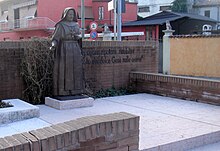Maria Pia Mastena

Maria Pia Mastena (born Maria Teresa Mastena ) (born December 7, 1881 in Bovolone , † June 28, 1951 in Rome ) was an Italian religious who is venerated as a blessed in the Roman Catholic Church . She founded the community of the Sisters of the Holy Face. Her memorial day in the liturgy is June 28th .
Life
Maria Teresa Mastena was born on December 7, 1881 in Bovolone. She was the oldest child of the married couple Julius Mastena and Maria Antonia Casarotti. Her mother taught her to read and write and Maria Teresa attended a day care center run by the Sisters of Mercy of Verona. At the age of nine, Maria Teresa received her first communion on March 19, 1891, and on this day also made her private vow of eternal virginity . On August 27, 1891, Maria Teresa received the sacrament of Confirmation . In her youth she was very involved in her parish and worked as a catechist . She made her first mystical experiences, which revolved around the veneration of the holy face and the holy Eucharist .
Maria Teresa felt called to religious life and wanted to join a religious community at the age of 14, but was only granted admission to the Congregation of the Sisters of Mercy of Verona on September 3, 1901. With the permission of her superiors, she made another private vow on April 11, 1903, the feast day of St. Gemma Galgani , Maria Terese: she wanted to be a sacrificial soul. On October 24, 1904, Maria Teresa made her profession and from then on bore the religious name Passitea Maria of the Holy Child .
Sr. Passitea Maria finished her training in Verona in 1905 and worked there as a teacher. In 1908 she was sent to a new school of the order in Miane , in the mountains near Treviso, where Sr. Passitea Maria soon became headmaster. During the First World War she stayed in Miane, which was close to the battlefields of the battles of the Piave . In the years after the war, the needs of the population in the charitable sector increased more and more. Maria Teresa did not feel up to these tasks, because she rather felt the desire to live a contemplative life in the seclusion of the monastery. Family tragedies, such as the death of her mother, also influenced the decision. Her superiors, however, did not want to allow her this life in isolation. So Maria Terese left the community and entered the convent of the Cistercian Sisters of San Giacomo di Veglia in Vittorio Veneto on April 15, 1927 , where she was given the religious name Maria Pia for clothing .
In November of the same year, the Bishop of Vittorio Veneto , Eugenio Beccegato, asked Sr. Maria Pia to leave the cloister in order to resume teaching the children, because his work as bishop was subject to great criticism in relation to social issues. Sr. Maria Pia returned to school between 1927 and 1930, first to Miane, then to Follina Carpesica and finally to San Fior . During this time, she developed the idea of founding a community dedicated to the holy face of Jesus Christ, whom she particularly venerated.
In San Fior she founded the Pious Work of Aid , which looked after children in need and taught them. Soon more women joined the work of Maria Pia and in October 1932 the local bishop recognized the religious community. Between 1935 and 1936 the community of the Sisters of the Holy Face was withdrawn twice; after a trip to Rome, the community finally received episcopal recognition back on December 8, 1936.
During the Second World War , the community established other convents in Italy and looked after soldiers and victims of the war, without distinguishing between Italians, Germans, Christians or Jews. On December 10, 1947, the community around Mother Maria Pia received papal recognition. In 1949, Mother Maria Pia decided to build a hospital in Rome to be looked after by the sisters of the Congregation.
Between 1950 and 1951, mother Maria Pia had serious health problems and suffered a heart attack. She died suddenly and unexpectedly on June 28, 1951 in Rome. Requien were celebrated in Rome and San Fior, among others, where she was buried.
beatification
Pope John Paul II raised Mother Maria Pia to Venerable Servant of God on July 5, 2002 and on November 13, 2005, she was appointed by Pope Benedict XVI. beatified .
literature
- Vasco Lucarelli: Immagine del suo volto. Vita di suor Maria Pia Mastena . San Paolo Edizioni, Milan. ISBN 978-8821553233
- Nicola Gori: Beata Maria Pia Mastena . San Paolo Edizioni, Milan. ISBN 978-8821553882
- Nicola Gori (ed.): Beata Madre Maria Pia Mastena: Il tuo volto, Signore, io cerco. Pensieri scelti. San Paolo Edizioni, Milan 2005. ISBN 9788821553226
Web links
- Homepage of the Sisters of the Holy Face (Italian)
| personal data | |
|---|---|
| SURNAME | Mastena, Maria Pia |
| ALTERNATIVE NAMES | Mastena, Maria Teresa (maiden name) |
| BRIEF DESCRIPTION | Italian nun, blessed |
| DATE OF BIRTH | December 7, 1881 |
| PLACE OF BIRTH | Bovolone |
| DATE OF DEATH | June 28, 1951 |
| Place of death | Rome |